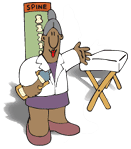|
What
is it about chiropractic care that makes it so effective?
Patients swear by the spinal adjustments they receive from
their chiropractor, but often don't know how the manipulation
is helping, other than a general knowledge that their backs
have been "cracked."
Adhesions in the hinge joints of the vertebrae, called the
facet joints, may be one reason for back pain. Adhesions,
or joints being improperly stuck together, can be caused by
reduced mobility from injury or inactivity. Chiropractic spinal
manipulation theoretically separates the facet joints and
increases the space between them, breaking adhesions and restoring
motion. One of the most common spinal adjustments performed
by chiropractors - the side-posture adjustment - involves
positioning a patient on his or her side, then rotating the
upper body using the shoulder and hip as levers. From here,
an adjustment is made with a slight twisting of the spine.
 In a study in the journal Spine, 64 men and women
ages 22-30 without back pain were divided into four groups
for varying treatment interventions, involving placing patients
in side-posture position only (without performing an adjustment),
providing actual side-posture spinal adjusting, or leaving
patients in a neutral position. MRI scans were taken before
and after interventions, in side-posture position or with
people lying on their backs, and compared for each individual. In a study in the journal Spine, 64 men and women
ages 22-30 without back pain were divided into four groups
for varying treatment interventions, involving placing patients
in side-posture position only (without performing an adjustment),
providing actual side-posture spinal adjusting, or leaving
patients in a neutral position. MRI scans were taken before
and after interventions, in side-posture position or with
people lying on their backs, and compared for each individual.
People given side-posture adjustments followed by MRI in
side-posture position showed the greatest separation in the
facet joints. Those in side-posture position alone, without
adjustments, showed the second-greatest separation before
and during MRI. Side-posture adjusting clearly created greater
separation than no adjustments. The average difference in
separation between neutral group subjects' facet joints and
the group receiving side-posture adjustments was only a few
millimeters, but the authors called this amount "not only
significant," but also "clinically relevant."
Reference:
Cramer GD, Gregerson DM, et al. The effects of side-posture
positioning and spinal adjusting on the lumbar Z joints: A
randomized controlled trial with sixty-four subjects. Spine
2002:27(22), pp. 2459-2466.
To read more studies on back pain treatment, go to https://www.chiroweb.com/find/archives/musculoskeletal.
|



